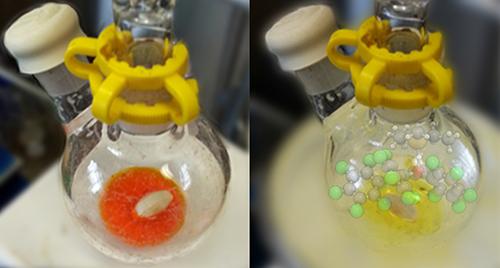Snapshots of chemical reactions: Characterizing an important reactive intermediate

Formation of the reactive borane-silane adduct at -80 Celsius is indicated by a color change. Credit: © Adrian Houghton. Artistic impression of the adduct © Akseli Mansikkamäki
Chemical reactions rarely go from starting materials to final products in one single step, but instead they progress through a number of intermediates. In many cases the intermediates are not stable enough to be studied by conventional characterization methods, which thwarts efforts to understand reaction mechanisms.
In the present case, the research group of Dr. Piers was able to undertake a comprehensive solution and solid-state characterization of an adduct between a Lewis acidic perfluoroarylborane and an electron-rich silane that has been postulated to be an intermediate in the 'frustrated' Lewis-pair hydrosilylation of C=C, C=O and C=N double bonds.
“The results of this paper are important because we now know more about the mechanistic details of a significant chemical reaction,” says Dr. Piers, a Tier I Canada Research Chair at the University of Calgary. “It is like travelling along the trans-Canada highway from Victoria to St. John's always blindfolded and finally being able to see the Rockies along the way: a breathtaking moment,” he explains.
However, characterizing an important reaction intermediate is only half of the story. Equally important is to understand what factors contribute to its stability and by how much. Here the research group of Academy Research Fellow Dr. Tuononen comes into play with the tools of theoretical modelling.
“Computational work showed that this is a good example of the Goldilocks effect in chemistry: everything needs to be 'just right',” tells Dr. Tuononen. “The calculations not only pinpoint the important contributors to the stability but also enable us to use this information to design similar adducts that are even more stable. This way we can study them experimentally in greater detail for further insight into the underlying chemistry.”
“Direct observation of a borane–silane complex involved in frustrated Lewis-pair-mediated hydrosilylations” by Adrian Y. Houghton, Juha Hurmalainen, Akseli Mansikkamäki, Warren E. Piers and Heikki M. Tuononen was published online in Nature Chemistry on September 28th, 2014. http://dx.doi.org/10.1038/nchem.2063
Picture: Formation of the reactive borane-silane adduct at -80Celcius is indicated by a color change © Adrian Houghton. Artistic impression of the adduct © Akseli Mansikkamäki
Funding for the work was provided by the Natural Sciences and Engineering Research Council of Canada (W.E.P.) and the Academy of Finland (H.M.T.).
More information:
Heikki M. Tuononen, tel. +358-40-805-3713, heikki.m.tuononen@jyu.fi Warren E. Piers, tel. +1-403-220-5746, wpiers@ucalgary.ca
Media Contact
All latest news from the category: Life Sciences and Chemistry
Articles and reports from the Life Sciences and chemistry area deal with applied and basic research into modern biology, chemistry and human medicine.
Valuable information can be found on a range of life sciences fields including bacteriology, biochemistry, bionics, bioinformatics, biophysics, biotechnology, genetics, geobotany, human biology, marine biology, microbiology, molecular biology, cellular biology, zoology, bioinorganic chemistry, microchemistry and environmental chemistry.
Newest articles

Superradiant atoms could push the boundaries of how precisely time can be measured
Superradiant atoms can help us measure time more precisely than ever. In a new study, researchers from the University of Copenhagen present a new method for measuring the time interval,…

Ion thermoelectric conversion devices for near room temperature
The electrode sheet of the thermoelectric device consists of ionic hydrogel, which is sandwiched between the electrodes to form, and the Prussian blue on the electrode undergoes a redox reaction…

Zap Energy achieves 37-million-degree temperatures in a compact device
New publication reports record electron temperatures for a small-scale, sheared-flow-stabilized Z-pinch fusion device. In the nine decades since humans first produced fusion reactions, only a few fusion technologies have demonstrated…





















